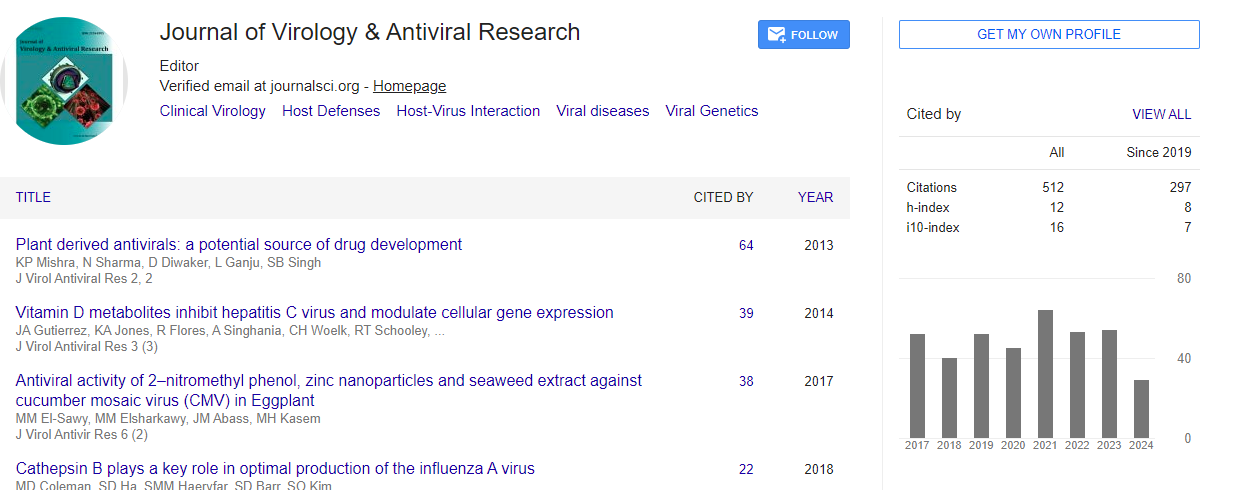Commentary, J Virol Antivir Res Vol: 13 Issue: 1
Viral Exaptation and Viral Gene Capture: Evolutionary Innovations in Viral Genomes
Paula Clément*
1Department of Genomes Evolution, CNRS University Paris, Gif on Yvette, France
*Corresponding Author: Paula Clément,
Department of Genomes Evolution,
CNRS University Paris, Gif on Yvette, France
E-mail: clement@egce.cnrs-gif.fr
Received date: 26 February, 2024, Manuscript No. JVA-24-136889;
Editor assigned date: 28 February, 2024, PreQC No. JVA-24-136889 (PQ);
Reviewed date: 14 March, 2024, QC No. JVA-24-136889;
Revised date: 22 March, 2024, Manuscript No. JVA-24-136889 (R);
Published date: 28 March, 2024, DOI: 10.4172/ 2324-8955.1000695
Citation: Clément P (2024) Viral Exaptation and Viral Gene Capture: Evolutionary Innovations in Viral Genomes. J Virol Antivir Res 13:1.
Description
Viral exaptation and gene capture are two pivotal mechanisms driving the evolutionary trajectory of viruses, facilitating adaptation to new hosts, evasion of host immune responses, and emergence of novel functions. This manuscript reviews the concept of viral exaptation and gene capture, exploring their significance in viral evolution, hostpathogen interactions, and the emergence of viral diseases. Through comprehensive analysis of recent studies and theoretical frameworks, we elucidate the mechanisms underlying viral exaptation and gene capture, their implications for viral fitness and pathogenicity, and their potential applications in biotechnology and medicine.
Viruses are ubiquitous entities that constantly evolve through various mechanisms, including mutation, recombination, reassortment, and horizontal gene transfer. Among these mechanisms, viral exaptation and gene capture represent fundamental processes driving viral evolution and adaptation. Viral exaptation refers to the repurposing of existing viral genetic elements or traits for new functions, while viral gene capture involves the acquisition of genetic material from other organisms, including hosts or co-infecting viruses. These mechanisms enable viruses to explore new ecological niches, overcome host defenses, and exploit diverse cellular pathways for their replication and propagation.
In this study, we delve into the concepts of viral exaptation and gene capture, exploring their molecular mechanisms, evolutionary consequences, and implications for host-pathogen interactions. We highlight recent advances in understanding these phenomena and discuss their relevance in the context of viral diseases, biotechnology, and medicine.
Viral exaptation encompasses a range of molecular events, including the recruitment of host cellular machinery, co-option of cellular genes, and utilization of viral proteins for novel functions. One classic example of viral exaptation is the evolution of retroviruses, which have integrated host-derived retrotransposons into their genomes, leading to the acquisition of regulatory elements and enhancing viral replication and persistence. Similarly, Endogenous Viral Elements (EVEs) in host genomes reflect past instances of viral exaptation, where viral sequences have become integrated into host germline DNA and may influence host physiology and evolution.
Viral gene capture involves the acquisition of genetic material from diverse sources, including other viruses, hosts, or even environmental reservoirs. Horizontal gene transfer events between viruses, known as viral re-assortment or recombination, contribute to the generation of genetic diversity and may lead to the emergence of novel viral strains with altered phenotypic properties. Furthermore, viruses can capture host genes through processes such as transduction, where host DNA is packaged into viral particles and disseminated to new hosts during infection.
The dynamic interplay between viral exaptation, gene capture, and natural selection shapes the evolutionary trajectory of viruses, allowing them to adapt to changing environments and host populations. Viral exaptation can lead to the emergence of viral proteins with novel functions, such as immune evasion, cell tropism modulation, or enhancement of viral replication. These innovations provide selective advantages that promote viral fitness and may contribute to the emergence of viral pathogens with increased pathogenicity or host range.
Similarly, viral gene capture events facilitate the acquisition of genetic diversity, allowing viruses to explore new adaptive landscapes and exploit alternative host species. Re-assortment between influenza viruses, for instance, enables the generation of pandemic strains with enhanced transmissibility and virulence, posing significant challenges for public health and disease control efforts. Moreover, the capture of host genes involved in immune modulation or cellular signaling pathways can confer selective advantages to viruses, enabling them to evade host immune responses or manipulate host cellular processes for their benefit.
The interplay between viral exaptation, gene capture, and hostpathogen interactions underpins the dynamics of infectious disease emergence and evolution. Viral exaptation allows viruses to overcome host barriers and adapt to new hosts or environments, facilitating crossspecies transmission events and the emergence of zoonotic pathogens. For instance, the adaptation of Simian Immunodeficiency Viruses (SIVs) to humans resulted in the emergence of Human Immunodeficiency Virus (HIV), leading to a global pandemic with profound public health implications.
Furthermore, viral gene capture plays an important role in shaping the virulence and transmissibility of emerging pathogens. The acquisition of virulence factors or host adaptation genes through gene capture events can enhance the pathogenic potential of viruses, leading to outbreaks or pandemics with severe clinical outcomes. Understanding the mechanisms underlying viral exaptation and gene capture is therefore essential for predicting and mitigating the risks associated with emerging infectious diseases.
Beyond their role in viral evolution and disease emergence, viral exaptation and gene capture have significant implications for biotechnology and medicine. Viral vectors derived from exapted viral elements, such as retroviruses or adenoviruses, have been widely utilized for gene therapy, vaccine development, and gene editing applications. These viral vectors offer efficient delivery systems for therapeutic genes, enabling targeted manipulation of cellular processes for the treatment of genetic disorders, cancer, and infectious diseases.
Conclusion
Viral exaptation and gene capture are integral processes driving the evolution of viruses and shaping their interactions with host organisms. These mechanisms facilitate the acquisition of novel genetic traits, enabling viruses to adapt to diverse environments, evade host immune responses, and emerge as pathogens of medical and veterinary significance. By elucidating the molecular mechanisms and evolutionary consequences of viral exaptation and gene capture, we can gain deeper insights into the dynamics of viral evolution, disease emergence, and host-pathogen interactions. Moreover, harnessing the principles of viral exaptation and gene capture holds promise for the development of innovative biotechnological applications and strategies for combating infectious diseases in humans and animals.
 Spanish
Spanish  Chinese
Chinese  Russian
Russian  German
German  French
French  Japanese
Japanese  Portuguese
Portuguese  Hindi
Hindi 

